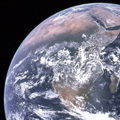« Prev Next »

Fire on Earth is a pervasive feature of the living world. Life created the oxygen that combustion requires, andprovides the hydrocarbon fuels that feed it. Today, through the agency of humans, life also supplies most ignitions, surpassing the previously dominant source, lightning. Fire takes apart what photosynthesis has put together; its chemistry is a bio-chemistry. Fire is not something extraneous to life to which organisms must adapt, it is something that has emerged out of the nature of life on Earth (Crutzen & Goldammer 1993; Whelan 1995; Bond & van Wilgen 1996; DeBano et al. 1998; US Forest Service, 2000a, 2000b, 2002, 2005, 2006; Bowman et al. 2009).
Fire is an ecological shape-shifter. As a reaction, not a substance, fire is what its circumstances make it. It is plural. It synthesizes its surroundings. Its taxonomy reflects this diversity, with the various types of fires distinguished by the combustibles they feed upon. A ground fire burns organic soil. A surface fire moves through grasses, forest litter, and shrubs. A crown fire flares through the canopy of brush and woods. A single burn may exhibit all these kinds of combustion. A single place may experience a medley of fires across seasons and years, varying in size, frequency, and intensity.
The resulting mix makes up fire’s regime. A regime is a statistical composite like climate. Just as a given climate can contain many kinds of storms, so a fire regime can hold many kinds of fires; but when they are grouped, they show distinct patterns. The geographic condition that underwrites regimes is the rhythm of wetting and drying. A site has to be wet enough to grow fuels and dry enough to ready them to burn, and how this plays out — and combines with ignition — affects the fire’s characteristics. The regime concept is vital, because organisms are no more “adapted to fire” (or not) than they are to water: they adapt to a pattern of burning. A trait suitable to survive one kind of fire may not help in another kind of fire.
This variability extends also to deep time. The geologic record contains fossil fires in the form of fusain (fossilized charcoal). These date back to the early Devonian, when plants first began colonizing land. Some places and eras have burned more than others, or in different ways. Major coalbeds, particularly those from the Paleozoic, include sizeable fractions from fossilized fires. Today, this process is reversed, with buried biomass being burned far faster than it is being stored. Similarly, molecular phylogenetics testifies to the ancient evolutionary role of fire as a selective presence. Earth’s pyrosphere realm of fire has thus effectively co-evolved with its biosphere and atmosphere. A change in one affects the others (Clark 1997; Scott 2000).
Fire and Life
The Effect of Fire on Organisms
Many plants show adaptations for coping with fire, some of which appear to be specific to fire, but most of which involve a suite of traits that accommodate a suite of stresses. Prairie grasses, for example, store most of their biomass underground, which helps the plant to survive drought, grazing, and fire (Figure 1).
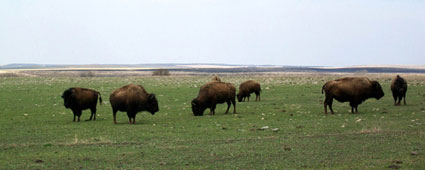
Some traits, however, do seem more targeted to responding specifically to the influence of fire. Thick bark on conifers, water-dense leaves surrounding buds on flowering shrubs, seed banks in mineral soils — all shield vital features against a wave of heat. Organisms slough off the heat or respond quickly after its passage. Aspen sucker after intense surface fires. Some pines can survive even crown scorch, and send out new apical buds. Many eucalypts resprout epicormically from under the bark, sending out new limbs to replace those seared, or can sucker from the roots. Resprouting after a bout of fire pruning is, in fact, a common feature, often seen also in areas subject to intensive browsing (Figures 2 & 3).
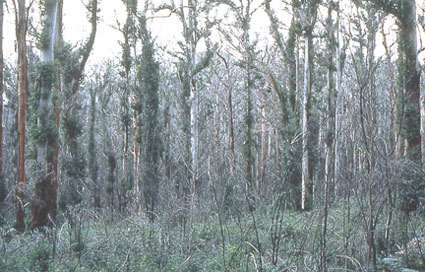
Some traits go beyond simple protection mechanisms against heat: they rely on fire to assure the organism’s reproductive success. Among the most interesting is serotiny whereby plants store seeds in the canopy within wax-sealed cones, woody capsules, or woody inflorescenses. These coverings shield the seeds against a pulse of flame, then open to release the seeds into an ashy surface. Similarly, a number of plants depend on heat or smoke to germinate seeds in the soil, or to stimulate buds to fruit. Heat-shock can crack open hard shells, liberating seeds or allowing for water to enter. Smoke alone can trigger flowering in some species, and a wave of chemicals released by fire can pass through the soil, both to fertilize and to purge it of toxins. Charcoal acts as a promoter of many annuals. The range of known chemical cues — in air, water, and soil — continues to expand, although many of their mechanisms remain mysterious.
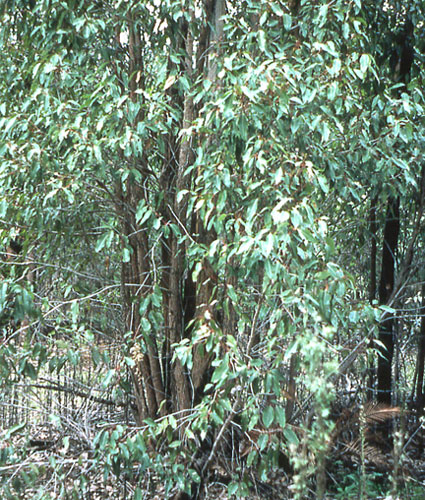
The critical consideration is how fires interact with the life history of the organisms. Adaptation involves certain kinds of fires burning at certain times in certain ways. Except where conditions are uniform, fires burn patchily. They also vary by intensity, size, frequency, and seasonality, and their effects vary accordingly. Yet much of this patchiness, timing, and flaming front (i.e., the fire regime), are the outcome of past fire history, and selection to protect against, or seize the opportunities presented by, fire. Cone serotiny works when fires flash through canopies, which requires a canopy capable of supporting such burns (Figure 4).
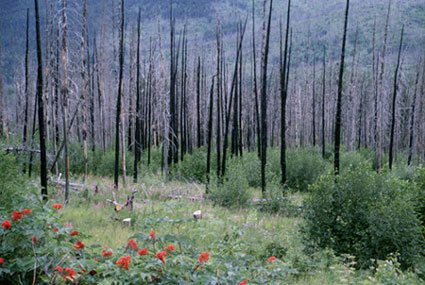
The Effect of Fire on Communities
At the landscape level, fire reorganizes both the structure and dynamics of communities. In some respects it resembles a massive physical perturbation, and in others it acts more like a colossal herbivore (Bond & Keeley 2005). In suitable settings it breaks down 80% of the above ground primary production, which converts biomass into liberated nutrients, alters the micro-climate, drives off some species and encourages others.
The physical breakdown of old structures, and the chemical breakdown of stored biomass, by fire’s spread is succeeded by the propagation of a front of chemicals into the air, soil, and water. In the short term, this shock can pollute. In the long term, it can rejuvenate, by freeing scarce nutrients (e.g., phosphorus), by stripping away insulating layers of organic debris, by exposing soil to sun, and temporarily shaking up the mix of competing species. Some organisms benefit from the new conditions, others suffer, and some will disappear if the right kinds of fires do not occur. These effects are felt mostly in the immediate aftershock. After three years or so, the scene has generally stabilized.
Humans as Regulators of Fire
Humans hold a species monopoly over the manipulation of fire: we are the keystone species for fire’s ecology. We influence fire both directly, by controlling ignition, and indirectly, by changing the environment within which fires operate. This control has increased over millennia to the point where the study of fire ecology without people is a hypothetical exercise, like the study of ideal frictionless surfaces (Goudsblom 1992; Pyne 2001).
Human hegemony began with control over ignition. People could start and, within limits, stop fires. The power of fire to spread, however, depends on the landscape to carry it. Still, people could alter regimes by changing the frequency, timing, size, and intensity of fires in places that were disposed to burn. Subsequently, people began manipulating fuels by slashing, draining, or otherwise mincing and drying surface biomass. They converted landscapes into combustibles, and again revised the pulses and patches that define fire regimes. All this is applied fire ecology: the rhythm of swidden farming, for example, maps exactly onto the 3-year rhythm of postfire recovery. To augment its firepower further, humanity turned to fossil biomass. People began burning landscapes buried in the geologic past, which required they combust those fuels in special chambers.
The effects of this pyric transition have underpinned global change over the past two centuries. Industrial societies not only replace open burning with internal combustion as a technology, they remove open burning from land practices. Fire’s ecology becomes one of fire removed. Meanwhile, the effluent of industrial burning has contributed hugely to the rise in greenhouse gas levels. It has polluted waters, it has altered soils, and it has remade every landscape it has touched. The Earth is dividing into two combustion realms: an industrial realm that burns fossil biomass, and a pre- or partially-industrial realm that burns surface biomass. The two overlap only in places and for transitional times. The pyrogeography of Earth is largely what humanity makes it (Figure 5).
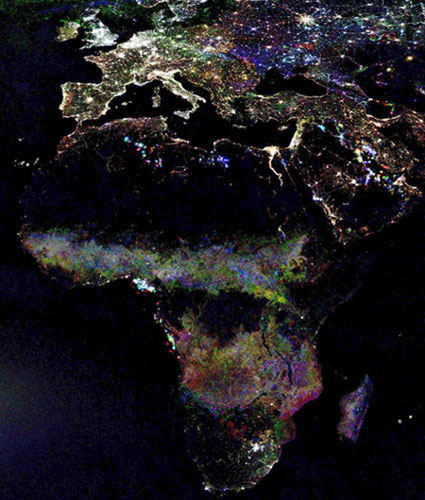
In the industrial world, fire is machined, cultivated, feral, or wild. It is burned in special chambers to produce heat and light without an open flame. It is used, selectively, in agricultural settings, where control over the fire comes from control over the cultivated landscape, or if that landscape has unraveled (e.g., from abandonment), the fires may go feral. And it thrives in wildlands or nature preserves that industrial societies like to create, and where fire as a natural process must continue to ensure ecological integrity.
So Earth remains a fire planet: it cannot be other than it is. While humanity’s pyrotechnologies are likely to be replaced in the future by energy sources that do not rely on combustion (with their greenhouse gas byproducts), open burning will persist where humanity’s control over the landscape is not complete and where people desire to perpetuate living landscapes that are largely natural or that have value for their cultural legacy. In such settings there is no technological alternative to fire, nor any ecological agent other than humanity to exercise stewardship over it.
References and Recommended Reading
Bond, W. J. & van Wilgen, B. W. Fire and Plants. New York, NY: Chapman and Hall, 1996.
Bond, W. J. & Keeley. J. E. Fire as a global ‘herbivore': the ecology and evolution of flammable ecosystems. Trends in Ecology and Evolution 20, 387–394 (2005).
Bowman, D. M. et al. Fire in the Earth system. Science 324, 481–484 (2009).
Clark, J. S. et al. eds. Sediment Records of Biomass Burning and Global Change. NATO ASI Series, Vol. 151. Springer, 1997.
Cochrane, M. A. Tropical Fire Ecology: Climate Change, Land Use, and Ecosystem Dynamics. New York, NY: Springer Praxis Books, 2009.
Crutzen, P. J. & Goldammer, J. G., eds. Fire in the Environment: The Ecological, Atmospheric, and Climatic Importance of Vegetation Fires. Chichester, UK: John Wiley & Sons, 1993.
DeBano, L. F. et al. Fire's Effects on Ecosystems. Chichester, UK: John Wiley & Sons, 1998.
Friederici, P., ed. Ecological Restoration of Southwestern Ponderosa Pine Forests. Washington, DC: Island Press, 2003.
Goudsblom, J. Fire and Civilization. London, UK: Penguin Press, 1992.
Pyne, S. J. Fire: A Brief History. Seattle, WA: University of Washington Press, 2001.
Scott, A. C. The Pre-Quaternary history of fire. Palaeogeography, Palaeoclimatology, Palaeoecology 164, 281–329 (2000).
United States Forest Service. Wildland fire in ecosystems. General Technical Report RMRS-GTR-42, vols 1–6 (2006).
Whelan, R. J. The Ecology of Fire. Cambridge, UK: Cambridge University Press, 1995.









